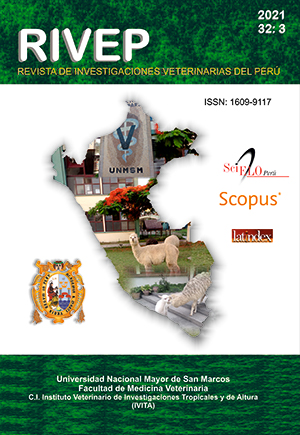Ivermectin residues in alpaca liver tissue (Vicugna pacos) in an abattoir in Arequipa - Peru, 2019
DOI:
https://doi.org/10.15381/rivep.v32i3.20418Keywords:
ELISA, antiparasitic, avermectins, liverAbstract
The objective of the study was to determine the presence of ivermectin residues in liver tissue of alpacas in an abattoir in the province of Caylloma, department of Arequipa, Peru. In total, 50 liver samples were collected and evaluated by competitive ELISA technique with a commercial kit. In addition, information was collected on the origin of the alpacas (Challhuanca, Tocra); age (less than 2 years, between 2-3 years, more than 3-4 years, and more than 4 years); sex (male or female) and breed (Huacaya or Suri). Results showed that 10% of livers were found to be positive for ivermectin residues with values that were above the Maximum Residue Limit established by the Codex Alimentarius for alpaca liver tissue (15 µg/kg). Positive samples contained levels between 17.28 to 79.10 µg/kg of ivermectin residues. Positive results were found for liver samples from different origin, age group, sex and breed, without finding a significant association with the presence of ivermectin residues. The results found suggest the need to implement residue control strategies at the slaughterhouse level to improve the safety conditions of food for human consumption.
Downloads
Downloads
Published
Issue
Section
License
Copyright (c) 2021 Efraín Cárdenas, Carlos Shiva, Elizabeth Hinostroza, Daphne León, Néstor Falcón

This work is licensed under a Creative Commons Attribution 4.0 International License.
AUTHORS RETAIN THEIR RIGHTS:
a. Authors retain their trade mark rights and patent, and also on any process or procedure described in the article.
b. Authors retain their right to share, copy, distribute, perform and publicly communicate their article (eg, to place their article in an institutional repository or publish it in a book), with an acknowledgment of its initial publication in the Revista de Investigaciones Veterinarias del Perú (RIVEP).
c. Authors retain theirs right to make a subsequent publication of their work, to use the article or any part thereof (eg a compilation of his papers, lecture notes, thesis, or a book), always indicating the source of publication (the originator of the work, journal, volume, number and date).










